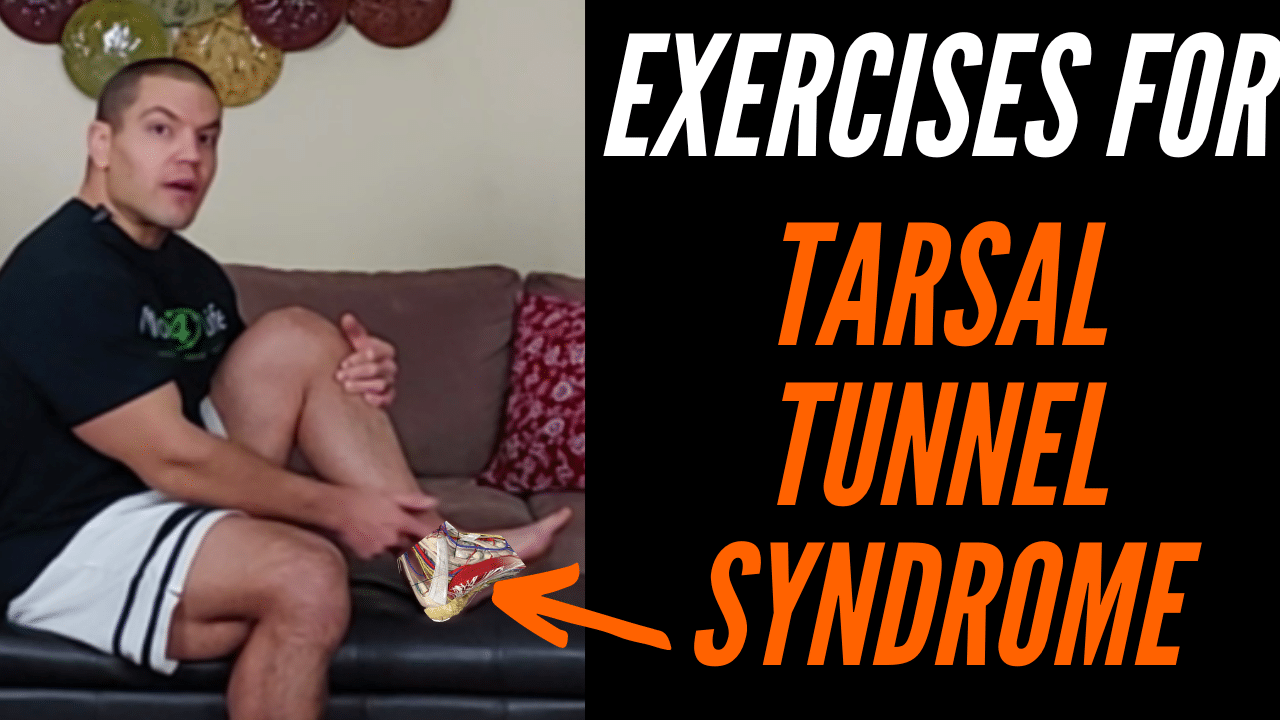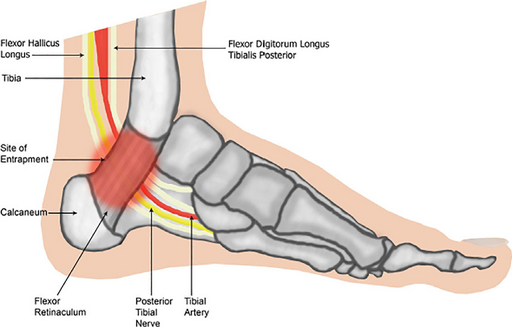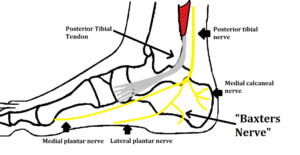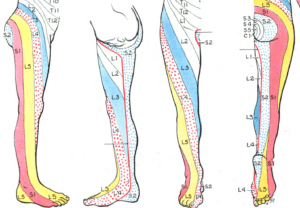Need Exercises For Tarsal Tunnel Syndrome?
Watch the video below to learn what causes tarsal tunnel syndrome, plus what exercises and other treatments can help relieve foot pain, numbness, and tingling.

What Is Tarsal Tunnel Syndrome?
Tarsal tunnel syndrome is a compression of structures that run through the tarsal tunnel at the ankle.
The tarsal tunnel is made up by a little ligament that goes over from the bump on the inside of your ankle (medial malleolus) over to your inner heel.
There are several different structures that run through the tarsal tunnel:
- tendons that go to your toes
- tibial nerve
- and then the tibial artery and the tibial vein
But the primary structure that's involved in most cases of tarsal tunnel syndrome is the tibial nerve.
The Tibial Nerve
The tibial nerve it splits and forms your planar nerves the medial plantar nerve and the lateral planar nerve and the symptoms of tarsalt unnel syndrome often get mistaken as plantar fasciitis.
What Are The Symptoms Of Tarsal Tunnel Syndrome?
Largely the syptoms of tarsal tunnel syndrome are pain on the bottom of your foot, burning on the bottom of your foot, or sometimes numbness or tingling in your heel or toes.
Therefore, tarsal tunnel syndrome can often be mistaken as plantar fasciitis.
Tarsal tunnel syndrome is often worse when you take the first step down in the morning after having not moved all night. So a lot of people do get misdiagnosed.
What Causes Tarsal Tunnl Syndrome?
well the most common cause of tarsaltunnel syndrome is over pronating orflattening your foot out too much whenyou're standing or when you're walkingor when you're running or doing otheractivities there are other things thatcan cause it like swelling in your footcan put pressure inside that tarsaltunnel inside that tarsal tunnel or ifyou have a ganglion cyst on the tibialnerve that can take up space inside thetarsal tunnel but largely the biggestcause of tarsal tunnel syndrome is thatover pronation or over flattening ofyour foot when you're standing orwalking for long periods of timeand so how do you prevent tarsal tunnelsyndrome well the biggest way that youdo it is you stop that cause you preventthat over pronation when you're walkingor when you're running and that helpsstop the symptoms of tarsal tunnelsyndrome so what are the exercises thatyou can use to help prevent thatoverpronation well largely they have todo with strengthening your arch musclesin your foot strengthening the musclesin your ankle the nerve the posteriortibialis that runs on the inside throughthe tarsal tunnel is actually one musclethat helps prevent overprotation so youdo not undo things to strengthen thatmuscle as well additionally doing nerveGlides for the tibial nerve can helpprovide movement and oxygen to thatnerve to help it stay as healthy aspossible and so I'll show you a coupleexercises that you can do the firstexercise is largely just working on thefoot or Arch muscles to maintain thearch and so to do that you're going tokind of scrunch your toes form like ashort foot bring the front part of thefoot towards the back part of the footwhile you're standing and so that wouldlook something like this where you'reslightly curling the toes and liftingthe arch and keeping it domed keeping itfrom falling down and then you're goingto progress that by AI trying to balanceon one leg while you keep that Archlifted and that's what you do every timeyou take the step when you walk or whenyou run you land on one foot over andover and over again and if you'reconstantly flattening down or overpronating when you're walking or whenyou're running it can stretch thestructures that run through the tarsaltunnel and pull them taut and over timethat can create an injury to them so ifyou're excessively pronating by allowingyour foot to flatten too much then youcan cause tarsal tunnel syndrome soagain the first exercise is just dopingyour arch and then when you can do thatprogressing to standing and balancingnow you can progress that even furtherby doing little mini squats again tryingto keep that Arch domed and that gets alittle bit harder to do so make surethat you have your balance down and thatyou can just stand on one foot with yourarchdome before you progress to doingthat mini squatnow what's another exercise for tarsaltunnel syndrome well one major cause ofoverpronation is stiffness in your calfmuscleand so if your calf muscles are stiffthen your body has to find a way to getyour weight out in front of the foot andif it can't do it by stretching yourcalf muscles it's going to do it byfinding an alternate route which usuallythat's over pronatedand so stretching your calf muscles isreally important but a lot of peoplestretch their calf muscles incorrectlybecause they allow the foot to flattenwhile they stretch their calves and thatdoes allow you to get further into thestretch it may feel like more of astretch or burn but it doesn't stretchthe areas of your calves that you needto stretch to prevent overpronation sowhen you're stretching your calves justlike doming your arch before you want tostart by doming your arch and thenstretching and keeping your heel flat onthe ground so you want to have the archdomes and keeping the heel flat on theground you may or may not actually feela stretch like this you may just feellike you can't go any farther but that'sokay it's more important to keep yourfoot from over pronating than it is togo super far into the calf stretchso that's the second exercise isstretching your calvesnow what's another exercise that you cando for Carson tunnel syndrome well whenyou get to the end range of taking astep when you're walking or when you'regoing to push off when you run you needto be able to move from a pronatedpositionum to a supinated position or increasingthe Dome of your arch as you go to pushoff that makes your foot a rigid leverso that you can push off of it and go onto take your next step and so doing heelraises is one good way to do that andwhen you're doing the heel raises youdon't want to allow your knees to kindof knock together like that or for thepressure to come too far inwards thatway you want to try to keep yourAchilles tendons going straight up anddown and moving up and down like thatand then if you can do that you canprogress to doing it on one leg for mostpeople including mostly myselfit's good to hold on to something tohave a little bit of extra balance whenyou're doing single leg heel raises butthat's the way that you would progressthe heel raises is starting on two legsmaking sure that you can keep yourAchilles tendons moving straight up anddown and not allowing your heel to go inor outwards too much and thenprogressing from there and moving to oneleg and again if you need to hold on forthat one-legged heel raise that'sperfectly fine to do thatnow what's the final exercise that youcan use for tarsal tunnel syndrome Imentioned before that doing nerve Glidescan help the tibial nerve which runsthrough the tarsal tunnel the tibialnerve is a branch of your sciatic nervewhich comes off of your lumbar spineruns through your hip runs down the backof your leg and then splits into thetibial nerve which is involved in tarsaltunnel syndrome and the fibular nervewhich goes down the outside of your legand into the top of your foot and sodoing the tibial nerve Glide what youstart with is start with your footturned outward that kind of tensions thetibial nerve around the ankle and thenyou'll start with the foot turned outand then just kind of kick up and downlike that you can add a little moretension by going into a slump positionand just going back and forthlike that with the foot kind of turnedoutward so it puts tension on the tibialnerve around the ankle now a key pointwith nerve Glides is you don't want todo them to the point of painum it's just designed to get movementand oxygen to the nerves and nerves needthree things to be healthy they needspace to move they need movement andthey need oxygen and if they're notgetting that that movement and oxygenthen they're not going to be healthy butlikewise if they're compressed fromeither over pronating or swelling insidethe tarsal tunnel they're also not goingto be healthy and so this particularexercise just works on getting somemovement and oxygen to the nerve but youdon't want the nerve to hurt when you'redoing it so keeping the range where youcan do it comfortably without causingpainso what are some other treatmentsbesides exercises that can help if youhave carsal tunnel syndrome well if it'san ankle problem you would think that anankle brace might be helpful and forsome extreme cases if you just don'thave the stability in your ankle toprevent yourself from over pronating andyour symptoms have gotten really badwearing an ankle brace can be ashort-term solution to help ease thesymptoms of tarsal tunnel syndrome butlargely it's not a good long-term fixbecause when you're inside that anklebrace your calves also tend to get stiffand that creates more of an issue downthe road so wearing an ankle brace canbe a good short-term solution but abetter option if your symptoms aren'tjust really really really bad is wearingOrthotics or insoles in your shoes tohelp prevent overpronationfor some people who don't have reallybad symptomsum just an over-the-counter pair ofinsoles can be helpful and I I can linkto some that we recommend uh super feedis one brand that we commonly recommendto patientsum but if you have a little bit moresevere of a problem or you've got kindof an awkward foot type you may needcustom orthotics and if you do and youhappen to be in the St Louis area we canget you fit for custom orthotics at morefor life just contact us our office andwe'll get you scheduled for anassessment for Orthoticsso what are other treatments besidesexercises and bracing in Orthotics thatcan help tarsal tunnel syndromewell other treatments for tarsal tunnelsyndrome include physical therapy now ifyou think that physical therapy is justdoing stretches and exercises that isone part but largely physical therapy atleast the way we do it at more for lifeis focused on finding the root cause ofthe problem figuring out what movementpatterns are causing the overpronationwhat muscles are involved is it just atthe foot or are there problems at thehip as well is it a problem with yourrunning technique so those are allthings that we would address in our typeof physical therapy as well as doingHands-On techniques like jointmanipulations or soft tissue treatmentsto the calves to help keep them frombeing so stiff or dry needling those areall good treatment options that can beprovided at Physical Therapy along withexercises for tarsal tunnel syndromeand finally what are the last resortoptions for tarsal tunnel syndrome wellyou can get injections in the tarsaltunnel or you can get surgery to releasethat ligament or flexor retinaculum onthe inside of the ankle but those trulyare Last Resort options the recoveryfrom that surgery can take up to 12months and the results are variablethere's no guarantee that you'll get agreat result afterwards so if you wouldlike to avoid surgery for your tarsaltunnel syndrome and get it feelingbetter naturally we'd be happy to helpyou out again just contact our officeand we'll get you scheduled for anappointment if you happen to be in theSt Louis area and if you're watchingthis from somewhere else but you foundsome of these tips helpful to betterunderstand your tarsal tunnel syndrome
Tarsal Tunnel Syndrome
Tarsal tunnel syndrome comes from irritation of the tibial nerve along the inside of the ankle.
The tibial nerve branches into the medial plantar nerve, lateral plantar nerve, and the medial calcaneal nerve.
The medial plantar nerve and the first branch of the lateral plantar nerve can cause foot arch pain that's often mistaken for plantar fasciitis.
Lower Back Nerve Roots (L4-S2)
The nerve roots from the lower back can cause referred pain into the feet. Foot arch pain can be causes by any of the nerve roots from L4-S2.
Attribution: Modified from Grant, John Charles Boileau, Public domain, via Wikimedia Commons
Often this type of foot pain occurs along with back pain and/or sciatica, but many times people don't connect their foot pain with their back pain or sciatica.
They think "I have back pain and plantar fasciitis" rather than realizing that the foot pain can be caused in whole or in part by their lower back nerves.
Foot Pain From Diabetic Neuropathy
Diabetic neuropathy often occurs in BOTH feet, not just one. It usually causes some numbness or tingling, along with a burning pain in the feet.
The best treatment for diabetic foot pain is controlling blood sugar through proper diet and exercise. Diabetic shoes can also reduce the risk of foot ulcers.
How To Relieve Foot Arch Pain
The treatment for foot arch pain largely depends on the cause. However, here are some general tips to relieve foot arch pain, whether or not it's plantar fasciitis.
Pronate The Proper Amount
For most kinds of foot arch pain, whether it's plantar fasciitis or not, avoiding over-pronation and under-pronation can help.
A foot that pronates too much will cause the foot to flatten and irritate the structures on the bottom of the foot - the plantar fascia, foot muscles, tendons, ligaments, and nerves.
A foot that doesn't pronate enough won't absorb shock and will cause too much shock, potentially causing heel pain, knee pain, hip pain, or lower back pain.
The RIGHT Kind Of Orthotics
Orthotics can help you support your arch and control pronation, but you need the proper type.
Off-the-shelf or poorly prescribed custom orthotics can be one reason why people continue to suffer with foot arch pain even after going through several different pairs of orthotics or arch supports.
Often custom orthotics from a podiatrist are hard and uncomfortable and just make your feet hurt more. People with TRULY flat feet need firmer orthotics to give structure to their arch.
However, if you have normal to high arches, you probably don't need a hard orthotic.
You may just need an insole offering cushioning and a little support to control how much your foot pronates when walking or running.
Or, if you have a high arch you might just need something to fill the gap between your high arch and your shoe to give you some shock absorption.
Want to find the RIGHT kind of orthotic for your foot pain?
Learn about our custom orthotics for plantar fasciitis, and other types of foot pain.
Exercises Can Help Foot Arch Pain
Calf stretches and foot stretches can also help various types of foot arch pain.
Don't Neglect The Things Above The Foot
Your hips control how you balance your body over your feet. If you have weakness in your hip muscles, it can cause your leg to twist inward and make your foot over-pronated.
As mentioned above, you also want to make sure that the nerve roots from your lower back aren't a contributing factor to your foot arch pain.
Want To Discover The Cause Of Your Foot Arch Pain?
Click the button below to request your Foot Pain Discovery Visit
Not Ready To Schedule A Visit?
Explore on your own our FREE copy of our Plantar Fasciitis Guide...






